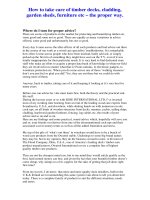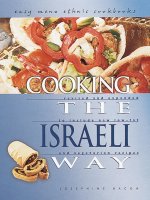cooking the turkish way
Bạn đang xem bản rút gọn của tài liệu. Xem và tải ngay bản đầy đủ của tài liệu tại đây (6.17 MB, 74 trang )
KARI CORNELL AND NURÇAY TÜRKO
˘
GL U
easy menu ethnic cookbooks
culturally authentic foods
including low-fat and
vegetarian recipes
the
way
Cooking
the
Turkish
way
Cooking
the
TURKISH
way
Copyright © 2004 by Kari Cornell
All rights reserved. International copyright secured. No part
of this book may be reproduced, stored in a retrieval system,
or transmitted in any form or by any means—electronic,
mechanical, photocopying, recording, or otherwise—with-
out the prior written permission of Lerner Publications
Company, except for the inclusion of brief quotations in an
acknowledged review.
Lerner Publications Company thanks our expert consultant
Nurçay Türko˘glu for her contributions to this book.
Lerner Publications Company
A division of Lerner Publishing Group
241 First Avenue North
Minneapolis, MN 55401 U.S.A.
Website address: www.lernerbooks.com
Library of Congress Cataloging-in-Publication Data
Cornell, Kari A.
Cooking the Turkish way / Kari A. Cornell and Nurcay Turkoglu.
p. cm. — (Easy menu ethnic cookbooks)
Summary: An introduction to cooking in Turkey, featuring such recipes
as spinach-filled Anatolian flat bread, lamb kebabs, and baklava. Also
includes information on the history, geography, customs, and people of
this partly European and partly Asian country.
eISBN: 0–8225–2173–3
1. Cookery, Turkish—Juvenile literature. 2.Turkey—Social life and
customs—Juvenile literature. 3. Low-fat diet—Recipes—Juvenile
literature. 4.Vegetarian cookery—Juvenile literature. [1. Cookery, Turkey.
2.Turkey—Social life and customs.] I.Turkoglu, Nurcay. II. Title.
TX725.T8C67 2004
641.59561—dc22 2003016543
Manufactured in the United States of America
1 2 3 4 5 6 – JR – 09 08 07 06 05 04
easy menu ethnic cookbooks
culturally authentic foods
including low-fat and
vegetarian recipes
Kari Cornell and Nurçay Türko˘lu
a Lerner Publications Company
•
Minneapolis
Cooking
the
tURKISH
way
Contents
INTRODUCTION, 7
The Land and Its People, 9
Regional Cooking,12
Holidays and Festivals, 14
BEFORE YOU BEGIN, 19
The Careful Cook, 20
Cooking Utensils, 21
Cooking Terms, 21
Special Ingredients, 22
Healthy and Low-Fat Cooking Tips, 24
Metric Conversions Chart, 25
A TURKISH TABLE, 27
A Tu rk ish Menu, 28
APPETIZERS, 31
Meat Pizza, 32
Zucchini Fritters, 34
Spinach-Filled Anatolian Flat Bread, 36
SOUPS AND SIDE
DISHES, 39
Red Lentil Soup,40
Shredded Wheat Soup
with Tomatoes, 41
Green Beans with Minced Meat, 42
MAIN DISHES, 45
Chicken with Rice,Tomatoes,
Peppers, and Tarragon, 46
Dumplings with Yogurt, 48
Lamb Kebabs with Tomatoes, Peppers,
and Onions, 50
Eggplant with Onion and Tomatoes, 51
DESSERTS, 53
Baklava, 54
Burnt Rice Pudding, 57
Almond Cream, 58
Tu rkish Delight, 60
HOLIDAY AND FESTIVAL
FOOD, 63
Flat Bread with Nigella Seeds, 64
Noah’s Dessert, 66
Baked Meat and Cheese Pie, 68
INDEX, 70
(Recipe on pages 68–69.)
7
Introduction
If you were to travel through Turkey, sampling food along the way,
you would be savoring a unique and rich cuisine that has been
ranked among some of the best cooking in the world. And you
would be tasting a bit of Turkish history. Along the coast of the
Aegean Sea, for example, olives and seafood—foods commonly
associated with Greek cuisine—are popular. Around 900 B.C.,
Greeks inhabited this coast, where they established the settlements
of Ephesus, Miletus, and Troy. The newcomers brought along the
traditions of their homeland, including favorite recipes.
Head eastward along the Mediterranean Sea and food begins to
take on the flavors of the Middle East. Dishes such as kebabs (chunks
of lamb, beef, or chicken roasted on skewers), hummus (pureed
chickpeas, sesame paste, and garlic dip), kısır (small patties made
from bulgur, parsley, and spicy tomato paste), and muhammara (a
spicy red pepper and nut spread) become more prominent. During
the time of the Turkish Ottoman Empire (1453–1909), Turks ruled
all or parts of modern-day Middle Eastern countries such as Iraq,
Syria, Saudi Arabia, and Egypt. They also ruled parts of many other
countries, such as Russia and Hungary.
8
But it was in Ïstanbul, the former center of the Ottoman Empire,
where the recipes traditionally thought of as Turkish originated. In
the vast kitchens of the Topkapı Palace, cooks dreamed up new
dishes in hopes of delighting the sultan, the great ruler of the
empire. Ottoman cooks were fortunate to have a wealth of fresh
vegetables, fruits, nuts, and meats from which to create the most
enticing foods. Traders from China and India traveled through the
Ottoman Empire on a network of trade routes, bringing spices such
as cinnamon, nutmeg, allspice, cloves, and cumin, many of which
found their way into traditional Ottoman recipes. Eventually these
recipes became popular throughout the empire, and they remain
favorites among Turks in modern times.
In this book, we’ve included a sampling of recipes that represent
the vast range of Turkish cuisine. We hope that you enjoy them all.
As Turkish cooks say to their guests, “Afiyet olsun!” This expression,
which means “Enjoy your meal,” is used both before and after
9
dinner. After indulging in these fine dishes, express your apprecia-
tion for food prepared by somebody else by saying “Elinize saglik!”
(“May God give health to your hands!”)
The Land and Its People
Turkey (Türkiye in Turkish) is known as the place where East meets
West and North meets South, both physically and in spirit. Because
of its strategic location where the continents of Asia and Europe
almost touch, Turkey has been important in world history and is the
birthplace of many great civilizations.
Although most of Turkey lies on the Asian continent in an area
known as Anatolia, the Turkish region known as Thrace is firmly
planted on European soil. The Bosporus Strait, a busy waterway that
connects the Black Sea in the north to the Sea of Marmara in the
south, marks the boundary between the two continents. The strait
also divides Ïstanbul, Turkey’s largest city. At different times, Ïstan-
bul was the capital of three great empires—Roman, Byzantine, and
Ottoman. Since 1920 Ankara, a city in Central Anatolia, has been the
capital of the Turkish Republic.
Turkey is one of the largest countries in Europe and the Middle
East. With a land area of 309,000 square miles, it is slightly smaller
than Texas and Louisiana combined. The country shares its western
border with Greece, Bulgaria, and the Aegean Sea. The Republic of
Georgia, Armenia, and Iran flank Turkey on the east, while Iraq,
Syria, and the Mediterranean Sea form Turkey’s southern border.
The Black Sea defines Turkey’s northern edge.
The area along the Black Sea receives more rain than does any
other part of the country. The Pontic Mountains rim this coastal area
and form a natural barrier, separating this region from the rest of
Turkey. The thick forests that cover the mountains provide lumber
for the boat-building industry, an age-old tradition. Tea plants,
whose leaves are dried and crushed to make the Turks’ favorite
10
drink, also flourish on these hillsides. In the winter months, the
fishing crews that cast into the waves off the coast catch primarily
anchovies (several varieties of small fish).
The terrain just inland from the rugged, dry Aegean coast is some
of the most fertile land in Turkey. Olives, grapes, figs, oranges, tan-
gerines, and artichokes flourish in the sunny, warm climate that
characterizes this region. Ancient Greek and Roman ruins along this
coast make it a popular destination for visitors.
To the south and east, the waves of the Mediterranean roll into
shore. Along this coast, the Taurus Mountains spike the landscape,
breaking up only between the seaside resort towns of Antalya and
Alanya. Off the coast of Antalya, fishing crews reel in fish such
as red sea bream, bluefish, red mullet, and bonito. Between these
two cities and the city of Adana to the east stretches a plain where
cotton farms predominate. The more tropical climate near Adana
provides perfect growing conditions for watermelons, oranges,
mandarins, and bananas. Farmers in this region have also begun to
cultivate mangoes, guavas, kiwis, papayas, and avocados.
In Turkey’s interior, goats and sheep graze along the mountains
and grasslands of the Central Plateau. A region called Cappadocia is
marked by soft volcanic rock that has been eroded over the centuries
to create unique land formations called fairy chimneys. Farther east,
extensive irrigation systems have transformed the once-barren land
into a rich agricultural area. Diyarbakir is famous for its watermel-
ons. Other crops that prosper in this area include wheat, lentils,
chickpeas, onions, sugarcane, peppers, spinach, pistachios, walnuts,
pomegranates, and plums.
Approximately 70 million people live in modern Turkey, and
most of them are ethnic Turks. The Turkic people were originally
members of a number of different nomadic groups from Central
Asia. In the eleventh century A.D., the Mongols, a powerful Central
Asian group, began forcing people out of the area, and many Turks
fled to Anatolia. One Turkic group established the powerful Seljuk
Empire in 1037. The Seljuks brought to Anatolia the Islamic faith, a
religion established on the Arabian Peninsula in the seventh century
A.D.that they had recently come into contact with. During the thir-
teenth century, other groups of Turks headed into areas along the
Sea of Marmara and the Aegean coast. One of these groups formed
the beginnings of the Ottoman Empire. Replacing the Christianity of
the Roman and Byzantine eras, Islam became the predominant reli-
gion. Although present-day Turkey is a secular (nonreligious) state,
99 percent of the population is Sunni Muslim, followers of a branch
of Islam.
The largest minority ethnic group in Turkey is the Kurds. Kurds
are spread out across Turkey, Iran, Iraq, Syria, and southern regions
of the former Soviet Union. Between 10 and 12 million Kurds live
in Turkey, mostly in the southeastern part of the country. Many
Armenians—people from the country of Armenia—live in Turkey
as well. Most live in Ïstanbul or around Lake Van in the eastern part
11
In the 1400s, Ottoman sultan Mehmed the Conqueror started building the majestic
Topkapi Palace in Ïstanbul.
12
of the country. Two Turkish subgroups, the Laz and the Hemßin peo-
ples, live between the Pontic Mountains and the Black Sea and main-
tain distinct cultures and traditions.
Turkey is also home to a small Jewish community. The majority of
Turkish Jews are descendants of those who fled to Turkey from Spain
in the 1500s during the Spanish Inquisition (a time when the Catholic
Church imprisoned, tortured, and killed non-Catholics). Many settled
in the Turkish cities of Ïstanbul, Ankara, Ïzmir, and Bursa.
Regional Cooking
The history of food in Anatolia stretches back to advanced agricultural
civilizations such as the Hittites, who lived in the region
in 7000 to 6000 B.C. Some foods—such as eggplant, tomatoes,
kebabs, and bread—are everywhere in Turkey. But the way these
foods are prepared varies from region to region, depending upon
local preferences and additional ingredients available.
Turkey is divided into seven climate regions, each of which makes
its own contributions to the country’s cuisine. The Marmara region
includes Ïstanbul and the communities surrounding the Sea of
Marmara. This small swath of land, where the cultures of Europe and
Asia blend, is the place to savor favorite Turkish or international
foods. Marmara is known for its Ottoman specialties, including fried,
baked, stuffed, or roasted eggplant; kebabs; and Turkish delight, a
popular candy. Seafood, such as the famous fish sandwiches sold on
the banks of the Bosporus in Ïstanbul and the region’s fried or stuffed
mussels, is very popular. The city of Bursa, located on the southern
shore of the Sea of Marmara, is home to the döner kebap, a specialty
kebab made from lamb, beef, or chicken. The meat, cut from the
skewer in thin slices, is served on pita bread (a traditional flat bread)
with yogurt and tomato sauce.
The Aegean region is known for its squid, which cooks typically
fry in a light batter to make a dish called calamari. Fresh fish and
13
shellfish, including stuffed mussels, are also particularly good here.
Olives, oranges, artichokes, and figs are just a few of the fresh fruits
and vegetables that grow locally.
Along the Mediterranean, several varieties of grilled fresh fish make
savory main courses. Tandır kebab, skewered meat cooked in a clay
oven, is a specialty in Antalya. In Alanya to the east, kuzu kaburga dolmasi,
lamb ribs stuffed with nuts, shredded meat, rice, and vegetables,
is a favorite local dish. This city is also famous for its jams. Mixed in
with the usual jars of strawberry, sour cherry, and apricot varieties are
preserves made from watermelons, carrots, pumpkins, roses, and
even eggplants. The kebabs served in Adana—called Adana kebap—are
spicier than those served in western Turkey, reflecting the Arabic
influence of nearby Syria. To prepare Adana kebap, ground lamb
is mixed with onion, paprika, and parsley, shaped into meatballs,
skewered, and grilled.
North of the Mediterranean coast lies the region of Central
Anatolia. Dishes based on pasta, pastry, or bread are especially popu-
lar in this part of the country. Gözleme, for example, can be savored
throughout Anatolia. This pancake of phyllo dough (flaky pastry) is
layered with spinach, onion, cheese, or other filling. It is folded,
grilled, and served like a sandwich. To make börek, another regional
specialty, cooks layer phyllo dough with meat or spinach in a clay pot
(tandır) and bake until it is golden brown. Kayseri, a town in the
Cappadocia region of Central Anatolia, is famous for pastirma, a
preserved meat, and for mantı, tiny pasta dumplings stuffed with
ground vegetables, lamb, or beef, and topped with a garlic-flavored
yogurt sauce.
In Southeastern Anatolia, Syrian influence is strong. Here the food
is spicy, and bulgur wheat replaces the rice that’s commonly served
alongside main dishes throughout the rest of the country. Typical
Arab dishes, including hummus, babaghannush (mashed baked eggplant
mixed with yogurt and garlic), and muhammara are prominent.
Eastern Anatolia has been home to the Kurdish people for centuries.
Kürt köftesi, a dumpling made from bulgur, chopped onions, and fresh
14
mint, is a traditional Kurdish dish. Van, a city that lies between Lake
Van and the Iranian border, is famous for van otlu, a sharp, white
cheese mixed with bits of grass. Egg dishes, such as çılbır—poached eggs
served with yogurt—are especially popular in Van. Malatya is known
for its sweet and abundant apricots. Many of the dried apricots available
in markets across the country come from this region. Malatya’s pestil,
dried apricots that have been mashed and flattened into thin sheets, is
famous. Another popular treat is küme, pestil layered with nuts and
rolled up into a log-shaped treat.
The Eastern Anatolian city of Gaziantep is known for its pistachios
and for its syrupy sweet baklava, a flaky dessert made with honey and
pistachios or other nuts. Pistachios are included in many local special-
ties, including fıstıklı kebap—spicy, ground meat rolled in crushed pista-
chios and then cooked—and künefe, a rich, gooey dessert consisting of
two thin, syrupy layers of dough stuffed with cheese and topped with
chopped pistachios.
Along the Black Sea coast, anchovies are popular—so popular that
they even make their way into local desserts. Hamsi tatlısı is a sweet pas-
try made from anchovies, flour, eggs, and fruit preserves. The salty fish
also flavors more traditional, savory dishes such as pilaf (rice that is
sometimes mixed with vegetables and spices) and börek. The Laz
people in this area are known throughout Turkey for baking a distinc-
tive corn bread. Their neighbors the Hemßin are famous for making
wonderful pastries and puddings. In fact, many of the renowned pud-
ding shops in Ïstanbul are Hemßin businesses.
Holidays and Festivals
Although Turkey is 99 percent Muslim, many of the country’s holidays
are secular in nature. Mustafa Kemal, known as Atatürk (Father of
the Turks) founded the Turkish Republic in 1920. This revered
leader shaped modern Turkey, making it more Westernized and secu-
lar than much of the rest of the Muslim world. He made many changes
15
in Turkey, including replacing Arabic script with the Latin alphabet,
introducing a Western-style legal system, and ending religious educa-
tion in Turkish schools.
In 1923 Atatürk made April 23 National Independence Day. Six years
later, Turks observed the first Children’s Day on April 23, a tradition
that has continued ever since. Children’s Day acknowledges the impor-
tant role children play in the future of all nations. On this day, hundreds
of children from throughout the world arrive in Turkey. They stay with
families in Turkish homes, sample Turkish foods, and experience
Turkish culture. On November 10, the anniversary of Atatürk’s death,
Turks observe a moment of silence to remember this great leader.
Turks host a number of other festivals throughout the year. Many
events, such as the International Film Festival in the spring and the
International Ïstanbul Festival in the summer, attract lovers of art films,
opera, ballet, and other performances to Ïstanbul. Festivals such as the
Cappadocia Wine Festival in Ürgüp and the watermelon festival in
Diyarbakır celebrate bountiful harvests.
Celebrating New Year’s Eve and New Year’s Day (January 1) is pop-
ular in Turkey. People wish friends and family a happy New Year by
sending greeting cards, e-mailing, or telephoning a few weeks before
the holiday. It’s very common for people to exchange small gifts on
A boy carries a Turkish flag to celebrate a holiday proclaimed by Atatürk (right).
16
New Year’s Day. People celebrate much like they do in the United
States, by throwing parties and listening to music. Turks also watch
television over the holiday, when local channels typically broadcast
their best programs.
For religious Turks, Ramazan—called Ramadan in many other
Islamic countries—is the most significant holiday. Ramazan takes
place during the ninth month of the Islamic calendar, the holiest
time of the year. The holiday commemorates the time when
Muhammad, the most important prophet in the Islamic faith,
received his first messages from god, called Allah in Islam. During
this sacred month, Muslims who are in good health fast by not eat-
ing or drinking from sunrise to sunset. (Pregnant women, the eld-
erly, and children do not fast.) To prepare for the daylong fast,
people eat a big meal, called imsak or sahur, before dawn. The meal,
which typically consists of soup, bread with jam, olives, pastries,
dates, and tea, provides energy for the daylight hours.
Just as the sun is setting, it is a tradition for children to go to the
neighborhood bakery to buy freshly baked pita. The children wait
in line, holding coins tightly in their fists. The baker gives each child
a hot pita wrapped in paper so it doesn’t burn their hands. On the
way home, children may sneak a bite of the pita.
The muezzin (a Muslim who chants the call to prayer from a
mosque, or Islamic house of worship) calls out an end to the fast at
sunset. Ïftariyelik, a snack commonly consisting of dates and olives,
satisfies people’s hunger until the main meal, called iftar, is served.
Men traditionally go to the mosque to pray while the women pre-
pare the food. And what a feast it is! Soup, pastirma cooked with
eggs, kebabs, börek made with lamb or spinach, pilaf, and vege-
tables such as green beans and eggplant commonly fill the table. The
customary Ramazan dessert is güllaç, a mouthwatering pastry made
from rice wafers, sweetened milk, rose water, and walnuts.
Three days of celebration, called Íeker Bayramı, end the month-
long Ramazan fast. Most religious Turks try to return home to visit
family for Íeker Bayramı. In preparation for the holiday, people
17
shake out the carpets, scrub the floors, and dust the furniture, ensur-
ing that everything is in order for visiting family and friends. People
dress in their best clothes and feast on sweets such as baklava, sütlâç
(rice pudding), and ßeker pare (syrup-topped shortbread cookies).
Dried apricots, pistachios, dates, almonds, and savory dishes made
from beans and lentils are also part of the Íeker Bayramı feast.
Yuvarlama, a soup made with chickpea dumplings, is the traditional
dish made to celebrate the holiday in Southeastern Anatolia. On Íeker
Bayramı, children look forward to more than just the fabulous
food—adults traditionally shower them with gifts and candies.
Another widely celebrated holiday in Turkey is Kurban Bayramı,
the feast of the sacrifice. Families, even those who are not devout
Muslims, celebrate the holiday by having a professional butcher
slaughter a sheep for them. Blood from the animal is dabbed on
children’s foreheads for luck. The family typically keeps some of the
meat and donates the rest to the poor.
The Mevlana Festival is an Islamic event that takes place each
December in Konya. This is the one time of year when visitors can
watch the whirling dervishes—members of a religious sect within
Islam—spin in a mesmerizing, age-old dance.
The whirling dervishes’ dizzying
dance dates back to the
thirteenth century.
Cooking any dish, plain or fancy, is easier and more fun if you are
familiar with its ingredients. The Turkish dishes in this book make
use of some ingredients you may not know. You should also be
familiar with the special terms that will be used in these recipes.
Therefore, before you start cooking, study the following “diction-
ary” of special ingredients and terms very carefully.
Be sure to read through the recipe you want to try from begin-
ning to end. Then you are ready to shop for ingredients and to
organize the cookware you will need. Once you have assembled
everything, you can begin to cook. It is also important to read “The
Careful Cook” before you start. Following these rules will make
your cooking experience safe, fun, and easy.
19
Flat bread makes a satisfying side for an entrée of chicken cooked with rice,
tomatoes, bell peppers, and tarragon. (Recipes on pages 64–65 and 46–47.)
20
The Careful Cook
Whenever you cook, there are certain safety rules you must
always keep in mind. Even experienced cooks follow these
rules when they are in the kitchen.
• Always wash your hands before handling food.Thoroughly
wash all raw vegetables and fruits to remove dirt, chemicals,
and insecticides.Wash uncooked poultry, fish, and meat under
cold water.
• Use a cutting board when cutting up vegetables and fruits.
Don’t cut them up in your hand! And be sure to cut in a
direction away from you and your fingers.
• Long hair or loose clothing can easily catch fire if brought
near the burners of a stove. If you have long hair, tie it back
before you start cooking.
• Turn all pot handles toward the back of the stove so that
you will not catch your sleeves or jewelry on them. This is
especially important when younger brothers and sisters are
around.They could easily knock off a pot and get burned.
• Always use a pot holder to steady hot pots or to take pans out
of the oven. Don’t use a wet cloth on a hot pan because the
steam it produces could burn you.
• Lift the lid of a steaming pot with the opening away from you
so that you will not get burned.
• If you get burned, hold the burn under cold running water.
Do not put grease or butter on it. Cold water helps to take the
heat out, but grease or butter will only keep it in.
• If grease or cooking oil catches fire, throw baking soda or
salt at the bottom of the flame to put it out. (Water will not
put out a grease fire.) Call for help, and try to turn all the
stove burners to “off.”
21
Cooking Utensils
Dutch oven—A heavy pot with a tight-fitting, domed lid that is often
used for cooking soups or stews
pastry brush—A small brush with nylon bristles used for coating food
with melted butter or other liquids
skewer—A thin metal or wooden rod used to hold small pieces of food
for broiling or grilling
strainer—A small wire mesh bowl with attached handle used to sepa-
rate liquid from solid food
Cooking Terms
beat—To stir rapidly in a circular motion
broil—To cook food under a direct flame
brown—To cook food quickly over high heat so that the surface
browns evenly
grate—To cut into tiny pieces by rubbing food against a grater
knead—To work dough by pressing it with the palms, pushing it out-
ward, and then pressing it over on itself
marinate—To soak food in a seasoned liquid in order to add flavor and
to tenderize it
mince—To chop food into very small pieces
preheat—To heat an oven before using it
puree—To make food into a paste or thick liquid
sauté—To fry quickly in oil or fat, over high heat, stirring or turning
the food to prevent burning
simmer—To cook over low heat in liquid kept just below its boiling
point. Bubbles may occasionally rise to the surface.
22
Special Ingredients
barley—A whole grain that is often used to thicken soups
blanched almonds—Almonds with the thin brown skin removed, avail-
able in the baking section of most grocery stores
chickpeas—Legumes that are yellow in color and slightly larger than
green peas. Chickpeas (also called garbanzo beans) have a firm tex-
ture and mild, nutlike flavor.
coriander—The ground seeds from the cilantro plant, used as seasoning
crushed red pepper—The dried crushed seeds and skin of a hot red pep-
per, used to season foods
cumin—The seeds of an herb used whole or ground to give food a
pungent, slightly hot flavor
currants—Small, seedless raisins used in Mediterranean cooking
eggplant—A vegetable with shiny, purple-black skin and light-colored
flesh that is very popular in Turkish cuisine
feta cheese—A soft, crumbly white cheese that is commonly made with
goat’s or sheep’s milk. Feta has a distinctive, salty taste.
fig—A sweet, dried fruit with many tiny seeds. Figs may be eaten
plain or used to flavor desserts.
garlic—A bulbous herb with a distinctive flavor used in many dishes.
Each bulb can be broken can be broken into small sections called
cloves. Before chopping a clove of garlic, remove its papery skin.
nigella seeds—A black, aromatic seed sprinkled on bread and pastries.
Nigella seeds (sometimes called black cumin seeds) are available at
Middle Eastern grocery stores. If you cannot find them, you can
substitute sesame seeds.
olive oil—An oil, made from pressed olives, that is used in cooking and
for salad dressing
paprika—Dried, ground sweet red peppers used to flavor or color
foods
23
phyllo dough—A flaky pastry rolled into paper-thin sheets that are
almost transparent. Phyllo dough can be made from scratch or pur-
chased from the frozen foods section of most grocery stores.Allow
the dough to thaw in the refrigerator for at least 8 hours before
using.
pine nuts—A rich, edible seed that grows on some pine trees
pistachios—A flavorful, light-green nut used to flavor many Turkish
desserts. The already-cracked shells of this nut are easy to remove,
but look for pre-shelled varieties to save time.
pita bread—Flat, round loaves of unleavened bread. When baked, a
puffed pocket of air forms in the center of the bread.
red lentils—Tiny, orange-red legumes used to make soups and spreads
in Mediterranean countries
rice flour—A flour made from ground rice and commonly used in
desserts
rice wafers—Thin crackers, made from rice flour, that are used in
Turkish desserts. Look for them in Middle Eastern markets.
rose water—A liquid distilled from rose petals that is used to flavor
many Turkish desserts. Look for rose water at your local grocery
store or in Mediterranean markets.
short-grain rice—A variety of rice with thicker grains that cook to a
sticky consistency. Short-grain rice is available at your local grocery
store or Middle Eastern market.
tarragon—A fragrant herb commonly used to flavor chicken dishes
yeast—An ingredient used in baking that causes dough to rise.Yeast is
available in either small, white cakes called compressed yeast or in
granular form called active yeast.
yogurt—A common ingredient in Turkish cuisine.To achieve the flavor
and thicker consistency of Turkish yogurts, strain plain, nonfat, or
low-fat yogurt through cheesecloth to remove extra water.









